#SEGA Saturn Spotlight
Text
Game Spotlight #6: Burning Rangers (1998)

Acquired Stardust tackles another Sega Saturn-exclusive title in 1998′s Burning Rangers! Come along with Ash as she takes a long look at a Sonic Team project from the very tail end of the Saturn’s life in America and some of the circumstances the platform was in at the time. An interesting game that has one foot firmly rooted in the past with Sega’s specialty in arcade gaming and one foot in the future with more experimental and narrative-focused games, it’s definitely a game worth your time with plenty of interesting history!
The year is 1998, and as the console wars of the time rage Sega finds itself a company in crisis. Multiple hardware missteps (iterative add-ons to their Genesis platform), internal divide between Sega of Japan and Sega of America over everything from release dates, hardware specifications and the purported “unsalvagability” of the character design of Sonic the Hedgehog according to Sega of America before the release of Sonic 1. There was also the matter of the looming release of Sony’s Playstation, a system Sega itself had a hand in creating after having previously declined working with Sony. It was a stunning reversal of fortune for Sega, who for a time seemed like they might just manage to steal the crown from Nintendo, particularly in the west.
It was this environment that lead to then-president of Sega Japan supposedly forcing then-president of Sega America, Tom Kalinske, to announce the immediate release of the Sega Saturn in the west at E3 1995, less than a year after its 1994 Japanese release. The surprise drop was handled in such a way that angered retailers, many of which refused to stock Saturn consoles and games, and the announcement of the immediate release and its pricetag lead to one of the most famous E3 moments of all time when then-president of Sony America Steve Race (himself a former employee under Sega’s Kalinske) walked on stage for a “brief presentation” and merely uttered “$299″, the price of Sony’s upcoming Playstation which was a whole hundred dollars less than the Saturn, before walking away, leading to an eruption of applause from the crowd. The feud between Sega America and Sega Japan didn’t end upon the 1996 resignation of Tom Kalinske either, with his successor Bernie Stolar (a controversial figure in his own right even beyond his time at Sega) famously saying “the Saturn is not our future” in an interview with EGM in 1997, two years before the launch of the Dreamcast in late 1999. Suffice it to say that the Saturn had a troubled lifespan, and that’s to say nothing of the lack of a mainline Sonic the Hedgehog release for the platform.
Sega America might’ve given up on the Saturn long beforehand, and indeed never wanted it in the first place, but it saw a stable stream of releases in Japan and even managed to sell better than its successor, the Dreamcast, in total lifetime sales by the end of both systems’ lifetimes. It is this environment that saw the release of Sonic Team’s Burning Rangers in 1998, one of only a shocking seven games released on the Saturn that entire year in America compared to a much larger number in Japan, which saw releases well into 1999.

Sonic Team may not have released a mainline Sonic the Hedgehog game on the Saturn, but we did get two non-Sonic releases from them in the form of NiGHTS into Dreams and Burning Rangers, two experimental titles that definitely saw Sonic Team testing out technology and ways of doing things that would find their way into the later Sonic Adventure series. Having felt that gaming had become too centered around killing enemies, Sonic Team set out to create a game in which the player would be tasked instead with saving people, and the result of that was Burning Rangers. Set on a near(?)-future Earth where most of our problems and differences have been solved (boy is that an almost depressingly optimistic vision of the future, huh?), humanity’s main source of danger comes in the form of fires, which the titular Burning Rangers fight as something of a special taskforce comprised of what are essentially charismatic superheroes. The whole thing has an odd Overwatch vibe to it, right down to the design of one of two playable characters, Tillis, who resembles Overwatch’s Tracer to a really uncanny degree.
Speaking of the design of characters, the art direction in the game is pretty awesome, possessing a certain anime coolness that the late 90s oozes. You know the time and vibe, right? Goggles, characters having poses with oddly specific hand gestures? That sort of aesthetic and energy is all over Burning Rangers, and it’s glorious. Along with the very ‘of its time’ vibe comes character names like “Lead Phoenix” (pronounced in the English dub of the game as ‘Reed Phoenix’), and one of the most insane and incredible names I’ve ever heard for a character in “Big Landman”. I’m not joking, that’s his actual name. And it’s great.
Along with the excellent art design is the animation, which is super high quality. In an odd coincidence, Burning Rangers was released on the exact same day in 1998 as Tenchu: Stealth Assassins which features a similarly beautifully animated array of acrobatics realistic and superhuman alike, though it’s worth noting that while Tenchu: Stealth Assassins was largely mocapped (by Sasuke/Ninja Warrior competitor Kane Kosugi and his father), Burning Rangers was supposedly mostly hand-animated. Helping to round out the presentation of the game is the audio design, which is purposefully minimalistic only featuring a few songs (one of which is sung in Japanese by Takenobu Mitsuyoshi). Seeking to immerse the player as much as possible, audio consists mostly of ambient noises of footsteps, fire and the chatter between the Burning Rangers taskforce over radio, and the intention definitely pays off because it really is rather immersive.
After selecting one of two playable characters (aforementioned cool anime hand man Shou Amabane and Tracer-before-she-was-Tracer Tillis), players are tasked with exploring a facility that is beset by fire, attempting to stop the blaze and rescue civilians along the way. In lieu of a map, Burning Rangers actually features a voice guidance system which has team leader Chris Parton give the player specific directions on their next destination along with the general radio chatter, which creates a surprisingly compelling and immersive experience, helped along by a voice cast that’s generally pretty good (though can be rough around the edges in English at times, mostly due to what seems like direction issues). Characters sound like just the right combination of charismatic, larger than life superheroes and real people doing their best to solve real crises across both languages.

Despite the serious nature of the story and the very real, relatable threat of fire and needing to rescue civilians from it, the difficulty of Burning Rangers is actually shockingly low, though your mileage may vary on whether that’s a good or a bad thing. I personally found it to be a very fun experience and was glad to not have to try excessively hard to get through the game’s four stages and four boss fights. Both playable characters also have different NPC civilians to rescue, with each civilian rewarding you with a followup email that contains more lore, simple banter about their lives or passwords for use after the game is beaten. There are also plenty of easter eggs in the game, such as being able to rescue various members of Sonic Team as in-game civilians, and the aforementioned password system that unlocks after the game is beaten which allows you to play as various otherwise unplayable characters like Lead Phoenix, Chris Parton and yes, of course, Big Landman.
Burning Rangers also bears a lot of hallmarks of Sonic Team, particularly the work they would do in the Dreamcast era. The player swims with a dolphin (Tillis can also inexplicably talk to animals), the final stage features Chaos-like blob monsters with it also inexplicably and very suddenly slipping into Sonic Adventure 2-style space colony scifi complete with a Maria analogue. It’s interesting to see some of the roots of Sonic Team working with these ideas and themes that resurface in later works, even with things that are more likely coincidences like another character named Big, a year before Sonic Adventure’s Big the Cat debuted.

The Sega Saturn may not have ever saw a mainline Sonic the Hedgehog release and although that absence is felt, in my opinion Burning Rangers is a very worthy title in the Sonic Team library and legacy, both contemporaneously and in retrospect. It’s a game that was incredibly innovative for its time in so many areas (interviews have since confirmed it was meant to be even more innovative, featuring 4-player online cooperative play in the year 1998), including managing to achieve transparent graphical effects which was thought to be extremely difficult to do if not outright impossible on the Saturn. It has unfortunately not ever received a port and therefore remains locked away on the Saturn, but its legacy lives on in things like the Sonic Adventure series, and even Overwatch which seems to pay homage to it in its premise and character design. It’s also an incredibly high note for the system to go out on in America, a justification for the Saturn’s existence despite Sega America’s reluctance to embrace it and at times hostility towards it.
A gem hidden among the stones, Burning Rangers is unquestionably stardust.
--Ash
#Game Recommendations#video games#retro games#retro gaming#sega#sega saturn#sonic team#burning rangers#ash#Acquired Stardust#game spotlights
12 notes
·
View notes
Text
Retro-Inspired 3D Platformer "Lunistice" Now Available on Nintendo Switch, Steam PC
Retro-Inspired 3D Platformer "Lunistice" Now Available on Nintendo Switch, Steam PC | #gaming #retrogaming #NintendoSwitch #Switch #PCgaming
Publisher Deck13 Spotlight has officially released throwback platformer Lunistice for Nintendo Switch and PC via Steam and GOG.
Created by the one-man developer at A Grumpy Fox, Lunistice is designed to be an approachable 3D platformer reminiscent of the 32-bit PlayStation/SEGA Saturn era.
Here’s the official breakdown of Lunistice from Deck13 Spotlight, followed by the latest trailer:
Follow…

View On WordPress
0 notes
Text
Guida ai giochi di ruolo giapponesi
Virtual Hydlide
Sistema: Saturn ◼︎ Sviluppatore: T&E Soft ◼︎ Uscita: 1995

Spotlight
Virtual Hydlide (ヴァーチャルハイドライド) fa parte della raccolta A Guide to Japanese Role-Playing Games, Bitmap Books, 2021. Creata in collaborazione con Kurt Kalata, A Guide to Japanese Role-Playing Games è una vera e propria enciclopedia che mira a coprire l’intera storia dei giochi di ruolo giapponesi dal 1982 al 2020. Oltre 600 titoli in uno straordinario libro di 652 pagine, disponibile sia sul sito di Bitmap Books che su Amazon.it.
Il periodo di gloria di Hydlide risale agli anni ’80, ma T&E Soft ha portato la serie nell’era dei 32 bit nel 1995 con Virtual Hydlide per Sega Saturn, pubblicato a livello internazionale da Atlus. Concettualmente, l’idea di base è piuttosto interessante: si tratta fondamentalmente di un remake dell’originale Hydlide, con un mondo di gioco non solo molto più grande, ma che viene generato casualmente da una manciata di mappe overworld e dungeon preimpostati. In questo modo ad ogni partita si ripetono pressoché gli stessi passaggi di base (trovare tre fate, combattere un vampiro, ecc.) e il gioco può essere portato a termine in poche ore al massimo; in teoria bisognerebbe giocarlo più volte per vedere tutto. Il gioco, inoltre, consente di ottenere una password nel caso in cui si desideri rivisitare mondi specifici.
In pratica, purtroppo, nulla funziona come dovrebbe. Questo stile di gioco di ruolo non era quello che il pubblico stava cercando, abituato ad avventure di lunga durata con una storia e dei personaggi complessi. Anche a prescindere da questo, tuttavia, Virtual Hydlide è, dal punto di vista tecnico, un vero disastro. L’intero mondo di gioco è renderizzato in 3D, ma la frequenza dei fotogrammi è atroce e i controlli imbarazzanti: si tratta di problemi comuni all’epoca, soprattutto nell’era precedente ai controlli analogici, ma qui è ancora peggio del solito. Gli sprite sono in 2D e il personaggio principale è in realtà un attore digitalizzato. Anche se in giochi arcade come Mortal Kombat questo aspetto poteva funzionare, in un titolo del 1995 risulta incredibilmente sciocco, soprattutto con tutte le ridicole armature fantasy che si possono equipaggiare.
Virtual Hydlide, tuttavia, è un “fallimento nobile”, quello di un progetto ambizioso e apparentemente inconsapevole dei suoi ovvi problemi ma che fa comunque del suo meglio. GB
_______________________
Quanto sopra riportato è un adattamento in lingua italiana - e non completo - dell’articolo originale in lingua inglese (tutti i riferimenti e i link all’articolo originale sono qui sotto). L’articolo è stato editato, tradotto, trascritto e pubblicato senza alcun fine di lucro.
Autore: Sconosciuto ◼︎ Da: A Guide to Japanese Role-Playing Games (US) ◼︎ Data: 25 giugno 2021 ◼︎ Immagini: MobyGames
Riferimento: A Guide to Japanese Role-Playing Games, Bitmap Books, 2021

Legal Disclaimer
From Hardcore Gaming 101: "Created in collaboration with author Kurt Kalata, A Guide to Japanese Role-Playing Games is an ambitious project that aims to cover the entire history of Japanese role-playing games from 1982 to 2020. As well as reviews of over 600 games, covering a wide range of sub-genres. Overall, the book weighs in at over 370,000 words and contains contributions from a wide selection of fans and journalists, combining to create the ultimate coffee table book on Japanese role-playing games". All materials are copyright of their respective rights holders.
_______________________
Tutti i diritti sono dei rispettivi proprietari.
0 notes
Text
Panzer Dragoon Saga: SEGA Saturn Spotlight #4

Original Release Date: January 29, 1998
Original Hardware: SEGA Saturn
Developer/Publisher: Team Andromeda/SEGA
At least as far as North American gamers went, Panzer Dragoon Saga never really got a chance to be assessed just on its own merits. SEGA of America's baffling decision to limit the game's print run meant that the game was considered rare immediately upon release. As the years passed without a reprint or re-release, the game's legend only grew. Some consider it not just the best SEGA Saturn game but one of the best RPGs of all-time, and I can't help but wonder how much its scarcity plays into that. It's a solid game with a lot of unconventional ideas that probably came about as a necessary result of tying it in with its rail-shooter predecessors, but I'm not sure I'm as over the moon with it as some appear to be. That being said, I would include it on any short list of the top Saturn RPGs, and the notoriety its rarity caused may well have made it the most famous Saturn-exclusive game.
That's a fitting title for a Panzer Dragoon game, I think. While the series did manage to spill out onto other hardware platforms, I personally feel that Panzer Dragoon is iconic of the SEGA Saturn in a way that no other brand is. The first game in the series was a highlight of an otherwise lackluster launch period for the console. Its sequel, Panzer Dragoon Zwei, remains one of the finest showcases of the Saturn's 3D capabilities. Then there's Panzer Dragoon Saga, a game that helped the Saturn blow off the doors on its way out. While many members of the developer Team Andromeda stuck around at SEGA to work on Panzer Dragoon Orta and assorted other projects, the team as a unit disbanded after Panzer Dragoon Saga. Team Andromeda was born on the Saturn, lived on the Saturn, and ultimately died with it.

Panzer Dragoon Saga began development not long after Panzer Dragoon Zwei. Having just come off the fairly successful first game, Team Andromeda split into two teams. One of the two teams, comprised of around 30 members, set about the task of making a direct follow-up to the first game's rail-shooting action. The remaining staff began work on Panzer Dragoon Saga. They would be joined by the bulk of of Panzer Dragoon Zwei's staff once that game was finished and released in early 1996. Most of the first year was spent simply figuring out the design challenges of adapting the shooting action into a role-playing game format. Fortunately, they had the rather capable Panzer Dragoon Zwei engine to use as a base for their game, so some of the programming obstacles were already addressed from the start.
Nevertheless, the development of Panzer Dragoon Saga was a serious challenge. Team Andromeda had virtually no prior experience developing RPGs, which proved to be a double-edged sword. They had to figure out a lot along the way, but their inexperience is likely what led to Panzer Dragoon Saga's many innovative ideas. They were not only embarking on their first RPG, but also a fully 3D RPG. More capable systems than the Saturn were largely relying on pre-rendered backgrounds to free up polygons for the characters, but Panzer Dragoon Saga rendered as much as it could in real-time polygonal graphics, allowing the camera more freedom. This was no mean feat for the Saturn, but Team Andromeda had a knack with the system that was nearly unmatched. If anyone was going to be able to get good results out of the Saturn on this particular front, it would be them.
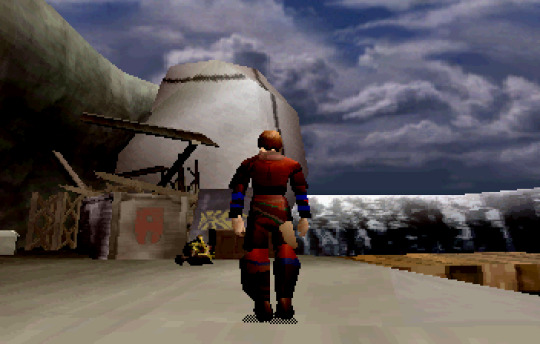
The game spent nearly four years in development and, for their part, SEGA threw a lot of resources behind it. The game featured an all-star Japanese voice cast, a vocal theme from the artist who performed the Japanese dub of Belle in Disney's Beauty and the Beast, and even made use of motion capture, a relative rarity at the time. The game also uses an extensive amount of pre-rendered CG video, the main cause behind it shipping on four discs. SEGA clearly had high hopes for the game, which likely put even more pressure on what was already the most ambitious project Team Andromeda had ever attempted. Tempers flared, relationships were damaged, and the game's director Yukio Futatsugi found himself having to take on a stricter role than he was used to. Two staff members died during the game's production, and Futatsugi believes it was due to the stress involved in the game's creation. Now, SEGA may have been restructuring their internal teams at the time anyway, but I doubt that was the only reason many members of Team Andromeda went their separate ways following Panzer Dragoon Saga's release.
By the time the game released worldwide in the first half of 1998, the writing was on the wall for the SEGA Saturn. The system still had a healthy following in Japan, but SEGA's subsidiaries in other countries were already preparing to clear the deck for their next (and final) console, the Dreamcast. SEGA of America was particularly strident about putting the ailing 32-bit console to rest. The person who oversaw the Genesis era where SEGA of America had found the company's greatest success, Tom Kalinske, had parted ways with the company a couple of years earlier after the Saturn failed to catch on. His replacement, Bernie Stolar, was brought in for a very specific purpose: to do for the Dreamcast what he had done for the PlayStation when he was the Vice President of Sony Computer Entertainment of America. Keeping the loyal Saturn owners happy wasn't one of his priorities.
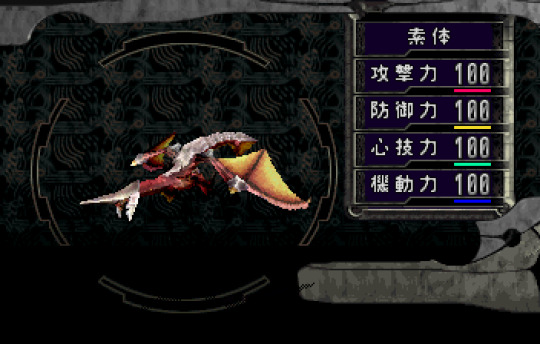
So it was that Panzer Dragoon Saga launched in America with a rumored shipment of 20,000 copies available for the system's 1.8 million North American owners. SEGA of America shorted just about every shipment of their last several Saturn releases, but Panzer Dragoon Saga was easily their biggest miscalculation in this regard. Stolar apparently had something of a disdain for RPGs, which may have had some business justification during his early years at Sony but looked positively absurd in a post-Final Fantasy 7 world. Panzer Dragoon Saga had a lot of buzz, and reviews of the game seemed to confirm that said buzz wasn’t just fluff, making it the highest-rated Saturn game ever released. Now, I'm not a fool. I know the reality of the Saturn's position in the world in 1998. But I also know that SEGA could have sold a lot more copies of that game than they did. They could probably more than double their sales of the game if they reprinted the Saturn version today, even.
Indeed, a reprint of the Saturn version of the game is probably the best we can hope for with regards to seeing Panzer Dragoon Saga re-released. Through some means or another, the source code for the game was lost almost immediately. No one has publicly gone on the record about what happened, but it was confirmed that it wasn't simply lost through carelessness. Given the volatile condition of Team Andromeda after the game was completed, I wouldn't be surprised if something happened to the code in the chaos. Thus, hopes for a re-release of the game are pinned on one of two possibilities: a from-scratch remake, or an emulated release. SEGA has always been shy about the former with regards to Saturn games, and while the latter is certainly possible on today's hardware, it's hard to say if there's a sufficiently large market for Saturn games to merit investing in a proper emulator.
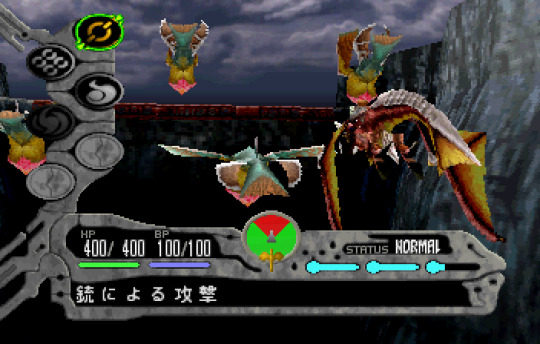
Fortunately for me, the Japanese version isn't terribly hard to come by. The game sold nearly 100,000 copies in Japan and doesn't have nearly the buzz around its collectibility that it has in other regions. You can therefore get your hands on good used copy of the game for under $30, an average price for a game released late in the Saturn's life. Since I sold off my only copy of the English version a while back, this was my only way to replay the game. Still, it was fun to play through the game in its original language. SEGA did a decent job on its localization, but games of this era often read better in Japanese than they do in English.
For such a big production, Panzer Dragoon Saga's story feels smaller in scope than the RPG trend at the time would dictate. The plot deliberately focuses on a small handful of people and while the stakes are high in one sense, you're not exactly trying to save the world, either. You play as Edge, a member of a mercenary group hired by the Empire to guard their latest excavation site. A monster attack leads to you discovering a mysterious girl buried in the wall of the site. No sooner do Edge and his companions make their way out of the site than another attack comes, this time from the rebel Black Fleet. They kill Edge's friends, grab the girl, and leave Edge for dead. After inputting your name, you'll watch a white light descend back into the site, where we find Edge miraculously alive, floating in some water.
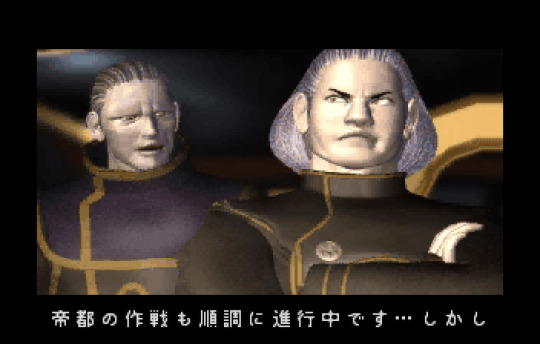
Edge soon joins up with the dragon and decides he'd like a hot dish of revenge for his fallen companions. He meets up with a scavenger named Gash who gives him some information in exchange for a ride. Edge eventually catches up with the Black Fleet and its leader, Craymen, but quickly comes to blows with the Fleet's newest ally: the mysterious girl Azel and her dragon Atolm. Craymen has made his way to one of the ancient towers, said to hold great power to those who can make use of them. Edge ends up clashing with Azel again, this time ending with both of them separated from their dragons and stranded together.
It's here that we learn Azel's story. She is a bio-engineered drone from an ancient era. She was designed for the purpose of interfacing with the towers, which is why Craymen was searching for her. The two eventually find their dragons again and go their own ways, with Azel warning Edge that she'll kill him if he crosses Craymen again. I don't want to spoil the whole game, but suffice it to say that a lot of parties get involved in this pursuit for power, and it's hard to know who you can trust. Craymen in particular has a lot of nuance to his character and even after all is said and done, it's hard to say whether he was wrong or right. There's certainly a lot of hubris to go around among just about every member of the main cast, at least.

Alright, I'd like to do two paragraphs of spoilers now. If you ever plan on playing the game, skip this paragraph and the next. Panzer Dragoon Saga makes use of a clever trick you might have seen before and may have seen since. The white light at the beginning of the game was you, the player, inhabiting the body of Edge, presumably bringing him back to life. You are the Divine Visitor destined to bring an end to the merciless rule of Sestren, an AI network that controls the towers and, through them, the world. The dragon that you've been riding for the past three games is actually a rogue AI program that Sestren purged, which is why it's able to change its form so easily. In each of the games, the dragon makes an attempt to cause damage to Sestren. In this game, it finally succeeds. Sestren falls, and humanity is for better or worse on its own from now on.
It's a future that Edge won't see. It's hard to say if he would have survived your essence leaving his body, but he ends up sacrificing himself anyway to put a stop to Sestren. Azel, having fallen in love with Edge and believing he is still out there somewhere, begins a search whose outcome we won't get to see in this game. Panzer Dragoon Orta, the final game in the series, sheds some light on what happens with her. It's a real downer of an ending, as we get to see how Edge's friends wait for him to return as he promised. We as the players and the agents of his demise know the truth, but they don't. This ending was another interesting way that the narrative subverted RPG norms.
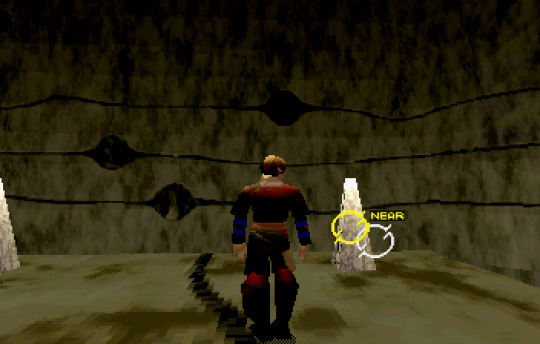
Okay, it's safe from here. I want to talk about the gameplay mechanics of Panzer Dragoon Saga, because it's here where the game really gets weird. For starters, your battle party will only ever consist of you and your mount. While many exploration sections have Edge walking around on foot, you'll mostly be getting around on the back of your dragon. To examine things in the environment, you have to lock-on to them the same way you would with your lasers in the previous games. This works for opening chests, manipulating switches, and even talking to people. The game uses an overworld map with points of interest on it. You simply direct your character to the area you want to go to and you'll enter it. This areas can be quite large and made up of multiple maps, so it's not like the game is hurting for size, either.
While there are some fixed battles here and there, most of the fights are random encounters. Once you're in a battle, the game's roots become clear. Your character has an action gauge that fills up over time. You'll need at least one bar to take any actions save moving around. Speaking of which, you can switch your positioning relative to the enemy at any time. Your action bar will freeze while you do this, however, so it's best to try to stick to one side as long as you can. Enemies will be weak from certain angles and use stronger attacks from others. One of the main strategies in the battles in Panzer Dragoon Saga is in using positioning to minimize damage taken and maximize damage dealt. Once you have your meter charged, you can fire off Edge's bowgun with precision aiming, fire a scattered shot of homing lasers courtesy of the dragon, or make use of one of the dragon's special abilities. These function sort of like magic does in other RPGs, dealing some heavy damage, buffing your character, or even healing.
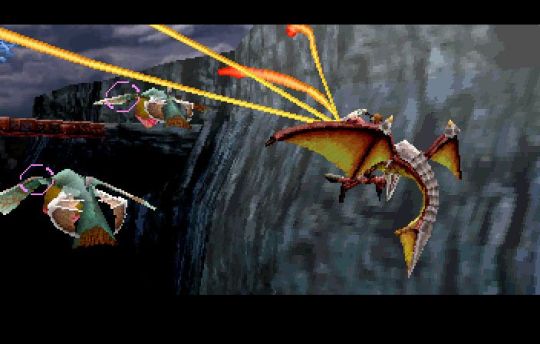
I'll grant that it's not the deepest system around, but it's awfully fun. You have to learn each enemy's quirks, figure out which ones you want to prioritize in mixed groups, and act quickly to avoid taking more damage than necessary. You'll probably find yourself pounding on the buttons waiting for the meters to fill up, but it's still quite action packed thanks to the need to constantly shift your position. The developers really did capture the feeling of a Panzer Dragoon rail shooter while bringing it firmly into RPG territory. Lest you get too bored doing the same thing all the time, the game also features a system that allows you to change your dragon into a number of different types, each with their own stats and special abilities. This is done via a cool slider that morphs your dragon's appearance in real-time. So if you want to go in hard on direct combat, you can switch to the attack-focused form, for example. You have granular control over just how far your dragon leans into each stat, too. I don't think I've played any other RPG with a system similar to this, so it still feels fresh today.
The game hasn't aged spectacularly well from a visual standpoint, though. The CG videos look pretty good even now, but they are certainly of their era. The 3D graphics look alright when you're cruising around on your dragon's back, but less so when you're on foot or in towns. The battles are probably where it shines the most, which makes a lot of sense. Most of the battles opt for some truly cinematic camera angles from certain positions on the field. The developer largely controls what you can or can't see from any given angle, which probably gave them the freedom to cut loose in those fights. For a 3D Saturn game it looks great overall, even in its weaker portions, but I'm not sure how high of praise that is in the current year.
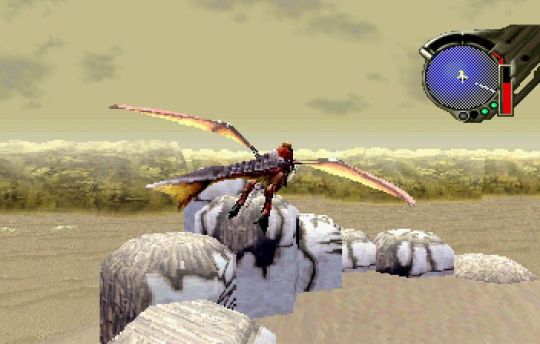
Naturally, the audio holds up just fine. The voice cast really was packed with talent, most of whom are still doing quite a bit of work in games and anime today. Composers Saori Kobayashi and Mariko Nanba turned in an outstanding soundtrack that matched the tone established in previous installments and taking things out a bit further to match the increase in scope. SEGA at one time sold an official soundtrack for the game that I would heartily recommend were it not, like the game, out of print. Hopefully one of the fine music companies releasing retro game soundtracks will eventually get to this one, because it deserves to be heard. I suppose with the game's 20th anniversary coming up next year, anything is possible, right?
Replaying Panzer Dragoon Saga was an interesting experience. Its legend has lost some of its shine for me over the years, so I think I was more able to understand its true nature this time around versus playing it in an ecstatic state brought on by actually finding the blasted thing. The lock-on interface is kind of cumbersome and screaming for a second stick. The graphics don't look all that great when you get close to things, but the camera choreography is still excellent. Along with the somewhat action-based system, it makes battles feel much more exciting than those found in most RPGs. I've played a few more games that used a similar narrative twist now, so that doesn't come off quite as impressively as it once did.
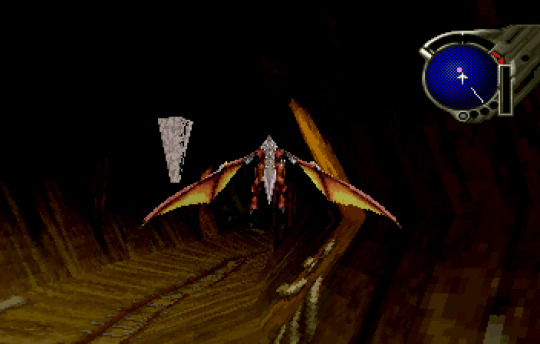
My biggest take-away from the game is that there's still nothing out there quite like it. Perhaps it's owing to its complexity, or maybe even its scarcity and resultant obscurity, but I can't think of any other RPG I've played that takes a similar approach to its battle system. I also appreciate the game's quick pace more than I used to. I find as I get older, I like it when a game doesn't waste too much of my time on filler. That's a big contrast from when I was younger, when time was apparently endless and new games came infrequently.
Above all, Panzer Dragoon Saga deserves to be far more widely-played. It's baffling that SEGA has yet to take a gamble on the game's notoriety with a re-release, even knowing what that would entail. Its ambiguous themes, innovative gameplay systems, and unusual plot would likely play quite well with modern RPG fans, and if that meant the game had to be rebuilt from scratch, well, the graphics could probably use that anyway. I won't go as far as to say this is one of the best RPGs of all-time, but it's really enjoyable to play and more than a little bizarre in its execution. I can't help but appreciate games like that.
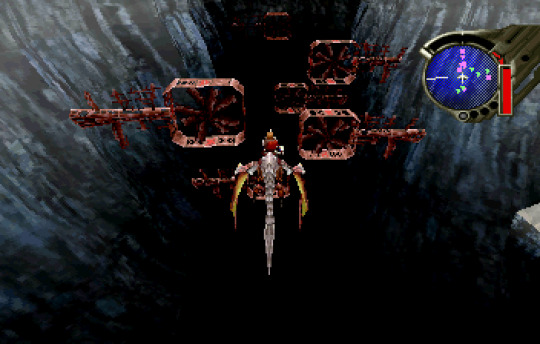
Previous: Shining the Holy Ark
If you enjoyed reading this article and can't wait to get more, consider subscribing to the Post Game Content Patreon. Just $1/month gets you early access to articles like this one, exclusive extra posts, and my undying thanks.
#SEGA Saturn Spotlight#sega#retro#gaming#sega saturn#rpg#panzer dragoon#panzer dragoon saga#team andromeda#azel#azel panzer dragoon rpg
12 notes
·
View notes
Note
Was thinking about the news story you broke back in the day about the working conditions and burnout leading to Sonic Unleashed and it made me wonder: is Iizuka actually as incompetent as fans make him out to be or has he been screwed by burnout from those under him and incompetence from executives above him?
I would not be surprised to learn Takashi Iizuka had suffered from burnout. Consider the timeline of events:
Takashi Iizuka leads development on SA2, Heroes, and Shadow at the newly formed "Sonic Team USA".
Shadow's development time was incredibly short. Just barely over a year, as I understand it.
As a result, either to save money or whatever, Takashi Iizuka did more than just direct Shadow, he helped create levels, he wrote the game's story, he directed the cutscenes, and more. He bent over backwards to ship that game.
After Shadow, Takashi Iizuka mysteriously wasn't a major part of the Sonic 2006 development team. I think he's referenced as special thanks or as a consultant, but he did not have a big role.
Instead, the moment Yuji Naka tendered his resignation, Takashi Iizuka helmed the long-awaited sequel to the Saturn game NiGHTS.
According to the story I broke, Iizuka had pitched NiGHTS 2 as a 360/PS3 game, and made a fair amount of progress on that version, but after the Wii was a breakout success, Sega executives demanded they shift development to become a Wii exclusive.
This entailed not only rebuilding the entire game from scratch for the Wii, but they weren't given any extra time or money to do so. Which means crunch time.
I believe the source said Takashi Iizuka was not happy with that decision, but was fairly powerless to stop it. He just had to make do with the orders he was given.
Unsurprisingly, both Shadow and NiGHTS 2 were very bad games.
After the NiGHTS sequel bombed, Takashi Iizuka more or less disappeared from the spotlight for, like, three or four years. He earned a couple of "Special Thanks" credits on things, but he didn't resurface in a meaningful way until Sonic 4: Episode 1 in 2010, where he started becoming the Sonic Team figurehead that spoke to the press. That's been the role he's taken ever since.
It really seems to me like he got burnt out on Sonic games after Shadow, and then after NiGHTS, got burnt out on all game development, period. He stepped away for a few years and then came back when he felt comfortable doing so.
I've spoken to people who have worked with him and they say he's actually an extremely nice, understanding person, and very knowledgeable. He was apparently instrumental in getting the Sonic Mania team the things they needed to make that game. I used to have a very poor view of him, but I've started being a lot more sympathetic. What we see of him from the public side is definitely not a complete picture of who he is or what he's tried to do.
(Though he definitely still makes statements that leave me scratching my head.)
16 notes
·
View notes
Photo

Indie Game Spotlight: Battle Chef Brigade
Hope you’re hungry because this week’s Indie Game Spotlight is on Battle Chef Brigade, a "fantasy cooking show" that pits warrior chefs against warrior chefs with a monster-hunting twist. The game follows the stories of Mina, Thrash the orc, and their friends as they compete in a fantasy cookoff with gameplay that's a mix of combo-based brawler hunting and match-3 puzzle cooking.
We sat down with Tom Eastman, the President of Trinket Studios, and asked some Q’s about this Monster Hunter meets Cooking Mama lovechild, which is available now on Steam, Switch, and PlayStation 4!

What inspired the story and characters in Battle Chef Brigade?
Eric Huang, the artist and visionary behind all the characters and world wanted to create a positive, friendly world that just happened to be obsessed with food. We looked to a lot of great cooking competition shows, like Iron Chef, Chopped, and Master Chef.
Battle Chef Brigade is often called a mix between Monster Hunter and Cooking Mama. What other games were most influential to your work?
The Sega Saturn game Guardian Heroes was a big influence. It's got really fun characters and lots of great combat animations.

When did you conceptualize the idea behind the game?
We were struggling with what game to make back in 2014 and turned on the Food Network during lunch. Something clicked and we realized that we'd never seen an improvisational cooking game that captured the excitement of having to figure out how to make a dish out of mystery ingredients.
Are there any funny/unique stories?
Despite knowing that we wanted to make an improvisational cooking game, it took us a long time to make a gameplay system that supported that. Since players can't lick their screens to taste their progress, it's important that the game is clear about that!

What game universe would be the worst to live out your life in?
Roller Coaster Tycoon because players are always starving or launching the customers into space.
What's your secret talent?
Training my dog. She's almost up to 40 commands, and is so stinkin' cute!
Want to put some cooking skills to the test? Battle Chef Brigade is available on Steam, Switch, and Playstation 4! Want to know EVERYTHING?! Make sure to check out their official website for updates, news, and everything Battle Chef Brigade.
5K notes
·
View notes
Link
Sega has detailed the events that it will feature at Sega Fes 2019, which runs from March 30 to 31 at Bellesalle Akihabara in Tokyo.
Get the details below.
■ 2F
Sakura Wars Exhibition
The crown holder in both the “Title Category” and “Most-Wanted Revival Category” in the “1st Sega General Poll” held at Sega Fes 2016, the Sakura Wars series will be on display in the form of artwork and valuable articles in the “Sakura Wars Exhibition.”

Great Atlus Exhibition
It has been 30 years since Atlus published its first title, Puzzle Boy, in 1989. Follow the history of Atlus, who grew alongside the Heisei era and always offers new worlds to the game market, in its first title joint exhibition, the “Great Atlus Exhibition.”

■ 1F
Mega UFO Catcher
The overwhelmingly big “Big UFO Catcher” from the previous Sega Fes returns, but this year it has evolved into the “Mega UFO Catcher.” This time the game nature is even greater, and the enjoyment and ease of catching has been upgraded to Mega-class!

Huge Sega Saturn Controller Pad
Play Fighters Megamix, Die Hard Arcade, and Hanagumi Taisen Columns on a huge Sega Saturn controller pad in celebration of the console’s 25th anniversary!

Huge Sega Logo Monument
The photogenic Sega logo monument returns again this year. Take a souvenir photograph before entering Sega Fes!

Sega Logo Taiyaki
The “Sega Logo Taiyaki,” which was sold for a limited time at Sega Taiyaki Ikebukuro, will be sold at Sega Fes 2019. Choose from the popular “sweet adzuki bean paste” and “premium cream” varieties. These will be available in limited quantities, so get them while you can!

Shirocoppe
The “Sonic Chili Dog” that just went on sale at Yawaraka Shirocoppe Akihabara will be sold at Sega Fes 2019 with original goods.

DARTSLIVE Experience Corner
Those who clear the conditions of the “Darts Challenge!,” which uses an event-exclusive game, will win a Sega Fes 2019 original t-shirt. You can also play darts with the LIVE QUEEN. And DARTSLIVE card holders can also receive a Sega Fes 2019-exclusive original DARTSLIVE theme.

Live Stream Booth
Sega Group information, presentations from developers regarding various titles, and the latest information on spotlighted titles—all live streamed.

Goods Corner
Tons of Sega-original goods are being prepared. Sales of Sega Fes 2019-exclusive goods are also planned.

■ B1F
Main Stage
Stages featuring the latest information on spotlighted titles with special guests, surprise announcements fit for Sega Fes, eSports tournaments, and more. Also, Hiroshi Fujioka will appear as a special guest for the “Sega Saturn 25th Anniversary Daikanshasai.” Stage events will be live streamed.
Sega has yet to announce the stage schedule for Sega Fes 2019.
—Featured in the teaser image: Kemono Friends 3, Persona 5, Puyo Puyo eSports, Border Break PS4, and Ryu Ga Gotoku Studio.

#Sega Fes 2019#Sega#Yakuza Series#Sakura Wars#Sonic the Hedgehog#Gematsu#Have some Sonic game news too please.
8 notes
·
View notes
Text
Game Spotlight #4: Bulk Slash (1997)
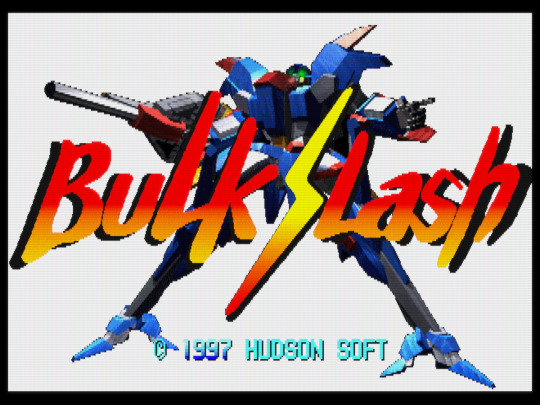
Acquired Stardust’s first spotlight on a Sega Saturn game! Come join Ash as she takes a look at a game that never made it outside of Japan with 1997′s Bulk Slash!
The Sega Saturn has long been a fascinating subject to me, its rise and fall perhaps the culmination of a whirlwind of internal company politics and a rapidly changing landscape of both hardware and software. The attitude among gamers well into the 6th generation of consoles was as though its failure was a foregone conclusion not through any nuanced variety of factors, but because “duh, the Saturn sucked!”, the sort of take that time and hindsight allows to fester into a comfortable, easily repeatable opinion that you’ve heard enough people say that you too assume must be true.
But I’m happy to report that in my time experiencing a variety of titles on the Saturn in an attempt to satiate my longstanding curiosity, the Saturn doesn’t suck! In fact, the Saturn has been something that has consistently delivered games that surpassed my expectations. Daytona USA brought home a legendary racing title with a soundtrack as infamous as it is glorious (I’m personally of the opinion that Takenobu Mitsuyoshi is a genius and his involvement in anything always makes me happy), Capcom’s legendary run of fighting games was captured almost in its entirety on the Saturn, having ports of Street Fighter 2, the entire run of the Street Fighter Alpha series as well as Darkstalkers and what was at that time the entire selection of crossover games with Marvel, all of which looked significantly better than their Playstation port counterparts. SNK brought its own excellent array of arcade fighting game ports to home consoles in multiple King of Fighters releases alongside The Last Blade.
All of this is to say that the Saturn had something of a reputation as a system dominated by high quality arcade ports, which at the time was a significant thing to be able to say about a home console. It’s a talking point that has settled into that comfortable space of easily repeatable factoid that may or may not be true, but in this case it is. The Sega Saturn was indeed home to high quality arcade ports, but something that’s lost in that conversation is just how many interesting, experimental and high quality titles don’t fit the mold of ‘taking something you played in the arcade and bringing it home’ - the Saturn-exclusive games. One such example is 1997′s Bulk Slash, developed by a little-known company called CAProductions in partnership with since-defunct publisher Hudson. It was only the developer’s fourth game, and their first try at the emerging world of 3D games, a world in which conventional wisdom is that the Saturn struggled with.
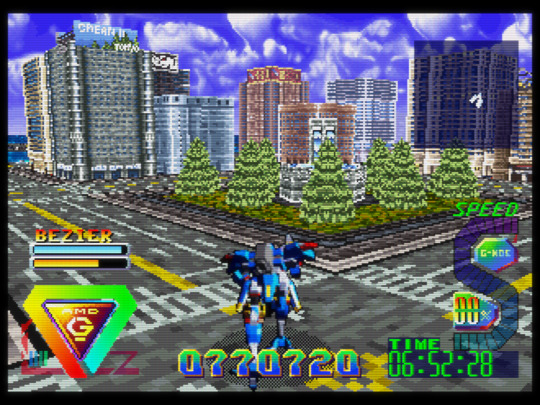
Bulk Slash is something of a mix of Macross and Zeta Gundam, stylistically. An action game with a mech that transforms into a jet, featuring a story about military factions causing trouble of the genocidal variety to avenge alleged oppression. Switching freely between mech and jet forms, the main character Cress pilots his conspicuously Gundam-like mech in a campaign to defeat the Gardona military which has managed to wrap up his childhood friend Riizen into its ranks through political events prior to the start of the game. Playing out across seven stages each with different goals and a boss fight to close out the mission, the player can collect various score-boosting items as well as health recovery items and weapon upgrades not unlike Contra or Metal Slug. Bulk Slash controls remarkably well for a game featuring both a humanoid combatant in its mech running around shooting and throwing grenades as well as a jet, all while not utilizing a secondary right thumbstick for camera controls, which are instead relegated to shoulder buttons on the controller. The action is fairly fast paced with an impressive frame rate, only slowing down in instances of large chained explosions going off in certain circumstances. Just as well, the graphics and art style are quite good (almost reminiscent of the rise of the recent ‘2DHD’ art style), and the soundtrack very fitting for its time though not especially memorable.
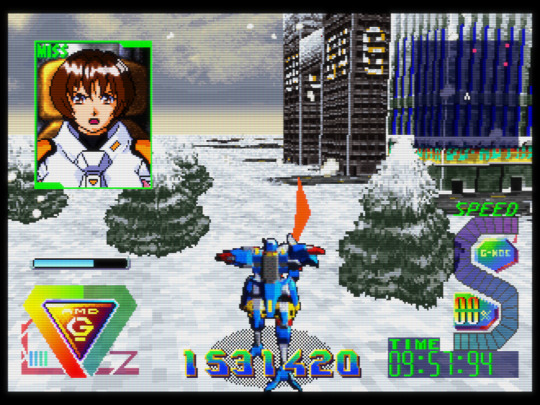
Layered into the fairly standard (albeit impressive) action gameplay is the ‘M.I.S.S’ mechanic (which stands for ‘Manageable Intelligent Support System’), a collection of 7 NPCs which must be located in each of Bulk Slash’s 7 stages serving as navigators for Cress, giving direction on the location of targets and bosses. Each of these NPCs are girls of various design, occupation and personality, including one who throws lots of English phrases into her otherwise Japanese speech which is very entertaining. Bulk Slash’s M.I.S.S system is more than meets the eye however, adding light dating sim mechanics into the game, with all 7 girls having their own endings and CG art unlocked depending on the player’s score upon defeat of the game’s final boss. It’s a small thing but really goes a long way in providing an experience that’s just varied and customizable enough. Having only 7 missions, the game is not especially long and only saves after successful runs through it after defeating the final boss, which itself has a boss gauntlet before it that can be a little rough while you’re still getting used to the game but if you put time into the game you’ll soon be able to defeat them without taking too much (or even any) damage, assisted by the fact that each of them seems to have timings for which you can score a critical hit, either dealing heavy damage or sometimes even outright destroying them in one blow.

Bulk Slash, as previously mentioned, was never released outside of Japan but the game is relatively simple to navigate and understand, being communicated very well visually. There was also a recent English translation patch which is a little hit or miss translation and localization-wise, but otherwise should assist people who don’t speak Japanese in understanding the story and character interactions, which is surprisingly good (and surprisingly dark at times) and a clear love letter to Universal Century Gundam.
Bulk Slash was the second Saturn game I ever played (after the all-time classic Daytona USA, for those wondering), and I’m glad it was such an early stop in the tour of the Saturn library because it shows off a lot of the strengths of the platform as well as bucking some of the usual talking points about the system, such as not doing 3D very well. It also layers in some of Japan’s big gaming trends at the time, such as dating sim elements most that most prominently and recently (at the time anyway) helped make Sakura Taisen a big hit on the platform just a year earlier. It’s a shame Bulk Slash never saw release outside of Japan as it would probably have done fairly well and be fondly remembered, and it’s definitely the sort of game that feels as though it would be pretty popular were it to have been an indie game releasing today.
A gem hidden among the stones, Bulk Slash is undoubtedly stardust.
--Ash
#Gaming#Video Games#Retro Gaming#Retro Games#Mech#Mecha#Sega#Saturn#Sega Saturn#Bulk Slash#Game Recommendations#Acquired Stardust#Ash#Gundam#CAProductions#Hudson#Hudson soft#Game Spotlights
6 notes
·
View notes
Note
You praised Fever 2's story a lot, but how do you feel about all the other stories in puyo?
Putting this in the tag, as an invitation for others to share their opinions on all individual Puyo stories as well.
Granted stories in Puyo Puyo are hardly uberly deep, but it would be interesting to see which ones really resonate with everyone.
Anyways, as for me:
Puyo Puyo
The game does have more story via MM: Michikusa Ibun and what’s told in the manual, but the in-game story is extremely minimalistic. Same goes for the character interactions, but it’s the first proper Puyo game and it’s perfectly passable for that.
Puyo Puyo Tsu
I never found Satan (or Schezo for that matter) creeping onto Arle to be all that funny, but I do appreciate how the PSX/Saturn versions have a lot of cutscenes, to the point where every character has two encounter scenes depending on the mode you play and that’s nice.
Puyo Puyo SUN
This one just wants to be a goofy excuse plot and it succeeds, since I find this to be the funniest Compile Puyo game (Compile’s humor is very hit and miss with me). I like this kind of plot for Satan more then the usual spat and it is nice to see Schezo and Draco get some spotlight, especially since I actually like their characterization here a lot, Schezo in particular.
Puyo Puyo~n
Doppelganger Arle and everything around her make this story for me, but even in general it’s a good one, a bit more involved then usual and all around entertaining, not to mention something a little different from the Puyo Story norm.
Puyo Puyo BOX
Can’t comment on this one too much due to the lack of a full translation, but I do know that it’s another wacky Satan plot and it does have some good moments, especially Schezo’s scenes and just how much Arle torments him this time around.
Minna de Puyo Puyo/Puyo Pop
Another Satan plot, but the writing really sells it, since this may very well be the most savage that Arle has ever been in any of the games and I love it.
Puyo Puyo Fever
With this being my first non-reskin Puyo game I naturally have a soft spot for this one, I also love the Fever cast and Amitie’s earlier characterization. With that said I do think that this feels more like a set-up for Fever 2, since most of the cast is pretty one-note, many important aspects of the Fever world aren’t established yet and the ending just leaves you with a question mark….which still hasn’t gotten better, since SEGA refuses to wrap plotlines up.
Puyo Puyo Fever 2
See this post.
Puyo Puyo 15th Anniversary
Yeah, there is no way to line up all the encounters into one coherent story.
Yeah, there isn’t any clear ending.
Yeah, the handling of the Compile characters can be questionable (not that that’s gotten much better in later games).
But you know what? I enjoy the characterizations for most of the cast and the character interactions far too much to care about these above points. This along with Fever 2 is where the Fever cast was at it’s best and there are actually hints of SEGA continuing past plot points, mainly with Oshare Bones and how his story here adds a lot of context to him owning the Memory of Chu in Fever 2.
So yeah, I love 15th’s story, second favorite next to Fever 2.
Puyo Puyo 7
…Yeah I hate this game’s story, it’s where most things that I don’t like about the current writing originated. It doesn’t help that the game feels like it’s trying to have more of a bigger plot, which is something I’d usually appreciate, but it’s riddled with plot holes and oddities, none of the cast is used well and the way Dark Arle was handled led to the complete waste of a cool idea, since nothing of interest is done with it.
Puyo Puyo 20th
Nowhere near as good as 15th’s writing to me, but it has it’s hits. I really like Maguro and Risukuma’s stories (and them just getting to do something period) for instance and Ocean Prince’s story actually adds layers to his character. With that said many annoyances that I have with the recent games apply here as well, which ultimately holds it back for me.
Puyo Puyo Tetris
Also a very flawed story when you get down to it, it runs on convenience, rather then organic story telling and once again, many personal annoyances are present here as well. On the whole thought, I find it easier to get some enjoyment out of this one, since I really like the Tetris characters, the relationship between Tee and Ringo, the localization is excellent and hillarious and Chapter 9 get’s credit for being the first time that SEGA got me to care about their take on Schezo.
Puyo Puyo Chronicle
I do know a fair bit, but I want to wait until the fan translation videos are done to fully comment on this one. With that said I do know everything there is to know about Rafisol and my open adoration for her should make blatant whether or not I think her part in the story was a success or not.
6 notes
·
View notes
Text
On Witch
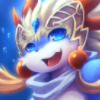
(So RP’s are a bit slow right now so I might as well continue down the saltapalooza that has been opened up due to a post on how Sega’s flanderized Amitie over the years.
This one’s kind of all over the place, because it’s not a strict flanderization argument per se and since Witch is my favourite I like to gush about her. I’ll try to keep on topic as much as possible though.
So I’ll start by saying that honestly, this could be a lot worse in several ways. Sega’s done at least a little homework on Witch. It took them nearly a decade to put Witch in one of their games (no, 7 does not count since she has no lines) but it looks like she’s here to stay seeing as she was kept on the roster for both Tetris and Chronicle.
But... Now what? See, my analysis has led me to the conclusion that Sega have absolutely idea of what to do with Witch.
I didn’t always have that viewpoint. At one time I thought Sega had done a pretty good job with Witch. She showed up, her story was reasonably funny, and she was actually allowed to behave like a selfish jerk unlike certain characters.
However, a little while ago I came across a translation of Yon’s cutscenes. And I came across an unfortunate discovery: Witch’s campaign in 20th is nothing new at all. Nope. It’s just a copy-paste of her few scenes in Yon, and one cutscene in Sun.
Let me elaborate. See, in 20th Witch is trying to collect ingredients to create a potion in one of Wish’s spellbooks. Collecting these ingredients involves taking parts off of certain cast members, namely Draco’s tail, the Acorn Frog’s eye, an imp’s horns, a ladybug, a dark wizard’s hair, and a fish’s scales. On the surface this isn’t a bad premise. I didn’t mind it too badly before I knew anything about Yon. Except in Yon, Witch’s goals are almost identical. She needs Draco’s tail and Seriri’s scales, and wants to collect Carbuncle’s finger grime (... somehow) just in case she ever needs it. When she comes across a sleeping Dragon, she also tries to seize the opportunity to grab some snot.
The details aren’t exactly the same, at least. Which is nice, because if the scenes were word for word the exact same I’d be even more peeved. I can at least give the writers that much. The thing is, after waiting so long for a beloved character’s comeback, why did they decide just to recycle half the cutscenes from other games? I suppose this can be forgiven since it’s an anniversary title, but it’s still a little odd.
And then we get to Tetris, where Witch has a total of... One scene. When DLC was released, she got another very short scene. While these were both original, there... Really was nothing to them. All she wants to do is perform an experiment with blocks in one, and in the other she mocks Draco, which would have been absolutely unsurprising if you had played either Saturn or Yon in the past. Witch’s appearance is very much a token one and she doesn’t even really interact with other characters besides Draco Centauros when there was an opportunity to have her bounce off of the members of the Starship Tetra, or Amitie, or Ringo. Or maybe to put her in Primp and have her hang out with some of the people she used to. Talk about a waste. Witch is a fun and dynamic character who has been allowed to remain a bit of a jerk. There was plenty of room to have her interact with new characters, but instead they threw her into space and called it a day. Hell, she’s a comet witch and she doesn’t even notice she’s in space!
Which leads me into the next part of this rant, the fact that Sega only really seemed to look at Yon and one cutscene in Sun and determined her entire character from there. Before Yon Witch was primarily a comet witch. While she did make potions in Seriri’s Happy Birthday, Witch’s gameplay was focused more on flight and spellcasting. Based on her moveset in other games, Witch not only shares most of Arle’s spell set (being proficient in fire, ice, and lightning magic, as well as being able to cast Brain Dumbed and Jugem) but has her signature Meteor spell and a few other comet style magics such as Big Bang. These spells have a distinctive star theme when she casts them, distinguishing her from Arle.
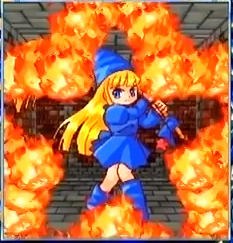
Pretty cool, huh? She is also somewhat of a melee fighter, not being afraid to swat people with her broom. (this isn’t the greatest of examples but it’s cool so)

Coming back to her broom flying, a whole game was built around it called Comet Summoner. It didn’t have much of a story, but it did feature a bunch of cute levels and a powerful boss that may or may not have been Witch’s future self. And this future self was strong, with a huge red aura, several health bars, and the ability to not only zip around the stage at high speeds, but cast spells of her own and combo you with a mix of melee and magic if you fuck up and get too close to her.
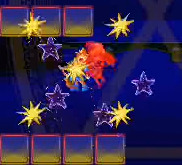
Witch would make a good fighting game character.
This is getting a bit off topic, but point is, Witch is versatile. But unfortunately it seems that apart from her spell names Sega can’t be bothered to remember her versatility and just wants her to make wacky potions. I’m not opposed to her making wacky potions, it’s not necessarily bad, but at one time she was a lot more than that.
She was more complex as a character than she seems to be in 20th or Tetris. Maybe not in Yon, where she appears very little, but in Madou Monogatari she got some attention. Yes, Witch is selfish. Yes, she’s pretty power hungry. Yes, she’d probably sell quite a few people out for a single corn chip. But there are some people who are dear to her, like for example her grandmother Wish. While again, I can’t read Japanese, Witch Leeroy Jenkins’s into a room when she sees her grandmother’s body on the floor in Tower of the Magician. Afterwards, Witch’s body language is pretty clear to see.


She’s clearly very worried about Wish and does not appreciate any harm coming to her. Even jerks have loved ones, I guess?
Let’s give Sega the benefit of the doubt, maybe that one trait just hasn’t come into play yet. After all, Wish hasn’t appeared (but she has been mentioned). Sure. However, there are other traits that the Sega games ignore when it comes to Witch’s character.
First, Sega has arguably made Witch into an even worse jerk. In Compile’s games, Witch is often abrasive and rude, but she will defer to an expert’s judgment in a situation she doesn’t understand. Case in point, Saturn. Upon coming across the Yog smoke, she avoids possession because she immediately listens to Arle and Rulue’s advice. She doesn’t argue, she just does it.
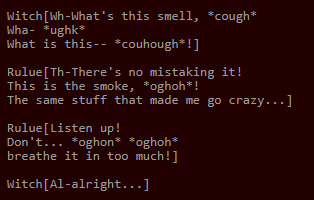
Contrast this with 20th.
In general, Witch is crafty and rather full of herself in Saturn, but not so much as Rulue. She has a low opinion of martial arts and so that makes her play well off of Rulue (It probably also explains her animosity towards Draco), while she has a high opinion of her magical skill and loves to soak up praise. Witch also shows little ill will towards those who quit the tournament after a Yog presents itself, which might hint at some sensibility the character doesn’t tend to have much of after this.

Witch is also a bit of a snarker in this game:


There’s character here besides her excitability, or getting pissed off when things don’t go her way. Now Saturn does bring up Witch’s legendary temper, but we don’t really see the results of that in-game. 20th really pushes that informed attribute into the spotlight, where all her thoughtfulness and cleverness go out of the window for her to make a bad potion that obviously contained too many substitutions, to the potion not being useful in the first place, to her beating up Lemres for stating the blatantly obvious. Witch doesn’t really come off any smarter than Draco at the end of this, because all of this was obvious! She just comes off as an even worse ass than usual because of Sega’s wackiness mandate.
I also really don’t get what the point of her fighting Lemres even was. Lemres seems disappointed at the end that he didn’t get to talk to Witch more, but the story just ends. There isn’t any kind of payoff or character growth here. Just... Nothing. Again, a total waste of potential, having the two comet mages meet and then do absolutely nothing of value. Love it, Sega.
Oh yeah, there were two more things Sega forgot about. First, this.



Witch is probably an actual pervert, to contrast with Schezo’s fake perversion (which may or may not be real perversion too sometimes, because Saturn’s fun like that). So that’s another thing Sega forgot, for better or for worse.
Which leads me to the last bit that Sega’s forgotten. This too I can’t really say if it’s a good thing or a bad thing. I like that it exists in Compile’s games, but if Sega remembered it would likely devour what remains of Witch’s personality. In certain games, there are implications that Witch may have a crush on Schezo. She fawns over him in athletic clothes in Puyolympics and as seen above, asks if he’s cool and wants to touch him in Saturn. Then of course there’s the whole “I want you” scene that solidifies the thing. For all I know there could be evidence for or against this in Tower of the Magician, which is a game where the two spend quite a bit of time interacting with each other, but since I haven’t learned to read Japanese in the last few hours I can’t comment on that, as much as I want to.
Now whether this is a good or bad thing for Sega to ignore really depends on your interpretation of this trait. I’m personally torn, because again I’m glad that Witch has not been reduced to a lovesick one-note failure. On the other, it’s a facet that a more competent writing team could have explored with some success. So it sucks that it’s been abandoned completely, but the end result could have been really terrible had Sega noticed this, so... Yay?
Okay, so I’ve written blocks of text. What does it all mean? Well, it means Witch isn’t immune to being flanderized in Sega’s works. It could be a lot worse, but there’s plenty of Witch’s character that’s been left out of current Puyo and plenty that has been aggrandized into a worse person. Right now Witch reminds me of a mixture of herself and Saturn’s take on Rulue, which... Really sucks, because no wonder Sega can’t figure out how to make Rulue stand out if they give her traits to other characters! Poor Rulue. Give her some love, Sega. She doesn’t deserve this kind of shafting.
As for Witch, you’re not going to get a total sweet kindhearted girl out of her. She was never that kind of character and that’s not a bad thing. But throwing on Rulue’s most boastful traits and making her a worse jerk, then giving her cameos because you don’t know what to do with her isn’t a good way to characterize her. Return some of that sense into the mix! Like I said in my Schezo comments, not everyone needs to be a wacky joke 24/7.

#puyo puyo#witch (puyo puyo)#madou monogatari#characterization#discourse#compile#sega#this one's even longer and less concise than the schezo one so apologies in advance#a lot of it's just generally talking about witch's character
20 notes
·
View notes
Text
E3 2021 Needs to Find a Way to Stay Relevant in Changing Times
https://ift.tt/3fNuMe3
The ESA has revealed that E3 2021 will run from June 12 to June 15 as an “all-virtual video game showcase that will be 100 percent free for attendees.” So far, the ESA is touting “early commitments from Nintendo, Xbox, Capcom, Konami, Ubisoft, Take-Two Interactive, Warner Bros. Games, and Koch Media” with more possible presenters to come.
Considering that the fate of E3 2021 was very much in doubt after last year’s event was canceled due to the COVID-19 pandemic, and companies everywhere hosted their own digital events as the ESA failed to organize the same, this announcement may be more than E3 fans could have hoped for. E3 shouldn’t be an in-person event quite yet, but a digital version of E3 featuring heavy hitters like Nintendo, Capcom, and Microsoft certainly feels like something close to that return to normalcy that so many of us crave.
Just as there are questions about what normalcy means after the events of the last year and the circumstances which propelled them, though, E3’s organizers, fans, and presenters will have to answer some tough questions about how the event will stay relevant at a time when its greatest attribute often feels like the memory of what was.
Make no mistake that E3 was in trouble even before the 2020 event was canceled due to circumstances beyond its organizers’ control. In recent years, studios like EA, PlayStation, Activision Blizzard, and even Nintendo (to a degree) decided to abandon their traditional E3 presentations in favor of their own dedicated shows and broadcasts. The reasons for their departures vary, but as Sony’s controversial (and largely underwhelming) 2018 E3 presentation showed, the pressure and costs of constructing a yearly presentation with competition undertones sometimes aren’t worth the potential payoff from a business perspective.
The absence of those companies was certainly felt at E3 2019 which had its fans but its best-remembered moment was a Keanu Reeves cameo that has lost some luster since we’ve all played the game that was clearly not ready for the spotlight it was afforded at that show.
Many of the companies that have left E3 have used the word “change” to justify their decision. Former Sony Worldwide Studios chairman Shawn Layden said in 2019 that “the world has changed, but E3 hasn’t necessarily changed with it.” In 2020, longtime E3 partner Geoff Keighley said that “the show does need to evolve.” Both Keighley and Layden noted their desire for E3 to look beyond the booths and show floor and find new ways to connect with fans, preferably digitally.
While leaks suggest that the ESA’s own suggestions for change involve an emphasis on influencers, live gimmicks, and even potential paywalls for digital content, E3 2021 doesn’t currently seem to feature any of that. Based on what we know now, it might actually be that largely digital event that will move beyond the physical boundaries of E3s gone by that some have complained about and instead reach a global fanbase directly in their homes. E3 2021 has a chance to become the E3 that some former major presenters seemed to hope it would become years ago.
However, the biggest potential problem with E3 2021 isn’t its changes but rather the expectations of the one group of people who seem most insistent that E3 doesn’t change: its vocal supporters.
There’s no universal reason why fans love E3, but the most common reasons fans look forward to the show tend to involve key elements such as the surprise of big game reveals, the competitive nature of the show (and subsequent arguments over who “won”), and the feeling of celebrating all things gaming during a big-budget week that seems to bring everyone to the same place one way or another.
There is no beloved element of E3s of the past that has become more outdated and dangerous than the expectations of the big reveal. A quick look at reactions to E3 2021 confirmation across social media reveals that fans are already hyping themselves up for the following games:
Metal Gear Solid and Silent Hill sequels/remakes
Grand Theft Auto 6
Metroid Prime 4
Breath of the Wild 2
Starfield
The Elder Scrolls 6
Maybe some of those games will appear at the show in some capacity, but we’re once again in a situation where the absence of impossibility fuels unreasonable expectations which burrow their way into even cynical minds and become the standard. What’s worse is that the hype for these potential announcements is amplified in many cases by the belief that E3 2021 will be different from the various digital events that we saw throughout 2020 which were hyped to the moon in the days leading up to their premieres but rarely featured the kind of big announcements fans hoped they would.
The fact that there’s a semi-popular belief that E3 2021 will be substantially different from recent events in that respect already suggests that not enough people have realized the situation the video game industry faces right now. As more and more games are delayed to 2022 and beyond, the impact of the COVID-19 pandemic on production schedules everywhere should be much clearer than it seems to be. Digital showcases weren’t underwhelming because they took place outside of E3; they were often underwhelming because studios were trying to figure out how to finish games from home while creating digital presentations from the same place. The elements that impacted the impact of those showcases are as prevalent as ever.
Even if they weren’t, pre-pandemic E3s have made it increasingly clear that those mind-blowing reveals that defined E3s of the past are becoming much rarer. Leaks, quarterly expectations, and a constant news cycle mean we rarely see a game at E3 that we didn’t already know or strongly suspect was coming. When we do (such as the reveal of The Elder Scrolls 6) it’s often for a game that is so far away that it might as well not even be confirmed. Yet, we still have fans expecting to see those games even as developers do everything in their power to tell us that they’re years away. Even those who know better find themselves weighing what we do see against the games they really want to know more about.
Read more
Games
Best Games to Play in 2021
By Chris Freiberg
Games
Best PC Games to Play in 2021
By Chris Freiberg
More importantly, the fact of the matter is that the video game industry is burdened by crunch culture and skyrocketing costs that often force employees to work unreasonable schedules to complete games that more often satisfy increasingly unreasonable ROI expectations than the vision of their creators or even the desire of fans. In that dangerous environment, we’ve built this monolith to gaming that seems bright to outsiders but is being propped up by the members of an overworked and sometimes unstable industry that must constantly find ways to satisfy a yearly expectation for the big new thing.
Yet, there may be no weaker E3 tentpole than the idea of industry competition. It’s absolutely true that E3s of the past directly played into that competition element. The very first E3 was even highlighted by Sony’s surprise PlayStation release date and price announcements which essentially ended the Sega Saturn’s chances before they even got started. Subsequent years also saw companies take potshots at each other in an attempt to steal the biggest spotlight the gaming industry had.
Now, though, we’ve got Microsoft and Nintendo working together, Sony putting PlayStation Studios games on Game Pass, and PC players laughing as they get more games than ever. It’s not that competition in the industry is gone so much as it is that companies really aren’t interested in continuing to take shots at competitors that they’re more willing to work with than ever before. What we’re often left with in the wake of E3 isn’t a debate over the best showing but a petulant justification for outdated fanboyism that rarely amounts to more than which console will get the special DLC hoodie in the next Assassin’s Creed.
That leaves us with the idea that E3 will live on as this event that gets people excited about the gaming industry and brings them together, which is honestly what E3 2021 is going to have to capitalize on if it’s going to battle against times that are slowly walking towards the door as E3 tries to keep the party going with stories of that time that went to the lake in college.
You can assign E3 a fiscal value, but I can tell you what E3 is worth to you. I also can’t deny that even the worst E3 tends to be more exciting than the best digital showcase we saw in 2020. After a year of searching for hope and answers, I’m looking forward to a generally harmless event that makes millions of people feel good and feel a connection with each other.
But in the same way that Blockbuster launched Blockbuster By Mail years after Netflix showed them what the future was going to be, I can’t help but feel that this year’s digital E3 showcase reeks more of necessity than the ability to read the room and truly innovate. What can E3 do with a host of presenters that already struggled to host their own digital showcases who must now scrape together enough new games to justify a spectacle? The show’s inability to innovate in years when it was positioned to do so raises serious doubt about its ability to innovate in areas that it’s intentionally avoided for years.
cnx.cmd.push(function() { cnx({ playerId: "106e33c0-3911-473c-b599-b1426db57530", }).render("0270c398a82f44f49c23c16122516796"); });
Maybe E3 2021 will be an effective enough stopgap and get us to E3 2022 when the novelty of being able to join crowds of people at a video game event (or watch those proceedings) will suddenly feel new again. However, E3 2021’s real job may be convincing us that this event has figured out something about digital presentations that has eluded some of the industry’s heaviest hitters so far.
If E3 2021 can capture that magical something that even mediocre E3s of the past have benefited from, then maybe it can overcome all of these hurdles. At the very least, it can delay the need to justify its place in a video game industry that keeps finding new ways to tell us that it needs to move on from the burden of our sometimes nostalgic ideas of what gaming was and what we want it to be. If it can’t, then those winds of change that we’ve been feeling more and more recently may blow over the empty halls of the L.A. Convention Center come June 2022 as we all realize that the tough answers to the questions of the future are rarely found in the past.
The post E3 2021 Needs to Find a Way to Stay Relevant in Changing Times appeared first on Den of Geek.
from Den of Geek https://ift.tt/3wGCKvJ
0 notes
Text
well folks, the PHW Sega Saturn devotional posts for its 25th anniversary month is coming to a close soon. I hope to have provided enough reasons why the Saturn should be remembered and held up with better regard and not let the Genesis and Dreamcast steal the spotlight every time people hear ‘Sega’. the mentality at the times that every new game had to have cutting edge 3D was shortsighted and underestimated even by Sega of America themselves. there were people like my brother, friends at the time and of course myself who rejoiced having 2D arcade perfect ports within the comfort of home like all the Capcom, SNK and Sunsoft offerings, and we only got a small fraction of these ports while Japan knew what was up. and when Saturn developers did do 3D right (as with Bulk Slash, Virtual On, Panzer Dragoon series and Burning Rangers) it was and still looks impressive but only with the right setup. so something as simple as not having an S-video cord was probably detrimental and the first year releases for Saturn were no doubt lackluster (to this day I hate Clockwork Night... how you go from cool guy Sonic to a skinny mustached dweeb like that for your console’s icon). well can’t change the past, so I’ll keep doing what I do to make the best of it. and as much as I dislike the mini-console fad, Saturn library might benefit from it since so many people slept on it (or straight up not even alive) when the best games didn’t cost a fortune like they do now. that is, if they get the emulation 100% right... we’ll see.
me @ me for not asking for Saturn Bomberman one Christmas:

for June I’m gonna focus on the Sega arcade games during this same time period (1994-1998) and why it was yet another big shame these games couldn’t be ported to Saturn (or Dreamcast with no graphical losses). Golden Axe: The Revenge of Death Adder and Sonic The Fighters would’ve brought the Genesis crowd back on board. would’ve also loved to see the Jurassic Park light-gun games (or the more rare Rail Chase ones) on either console, or an expanded Top Skater / Sega Water Ski etc. anyways, keep staying safe fam, and let me know if there’s something I haven’t been posting much that you’d like me to get back to throwing down on here. my mind is always in a million places but with a lil nudge I’ll get some focus going ;) PEACE LOVE & SEGA

#ending the month appropriately playing the final 4 saturn games released here#sega saturn#text#sega model 2
32 notes
·
View notes
Note
1. I don't think the voice acting was what made Mega Man 8 perform mediocrely in sales & put the classic series on hiatus. Part of it was just the Legends & X series stealing the spotlight, part of it was the lack of an N64 release, part of it was the deluxe version for the Saturn getting hamstrung by Sega's dumb marketing department shooting the Saturn in the foot by releasing it prematurely. 2. In the wake of BN4 & its Black Earth, I've started referring to BN3's Secret Area as "White Earth"
1) Yeah, there were kind of a lot of factors.
2) Huh. Kinda works, yeah.
2 notes
·
View notes
Text
getea 1 download
created by DMA Design and distributed by BMG Interactive for MS-DOS and Microsoft Windows in October 1997; adaptations for the Sega Saturn and Nintendo 64 were arranged, yet never settled. It is the primary portion of the Grand Theft Auto arrangement, and was created after its unique idea, named Race'n'Chase, was rejected because of creation issues.[5] The game spotlights on players assuming the function of a criminal who behaviors occupations for different organizations across three fictionalized variants of US urban areas, finishing levels by accomplishing a set score, however inside an open-world condition that permits them to do whatever they wish close by occupations to accomplish their objective.
Easiest way to download getea 1
The game was later re-delivered in December 1997 for the PlayStation, which changed it into a business accomplishment in spite of blended surveys from pundits. The achievement of Grand Theft Auto produced a progression of games, including a few side projects, through the span of 16 years, with the game prevailing by Grand Theft Auto 2 in October 1999.

Steps for downloading getea 1
Fabulous Theft Auto is comprised of six levels split between three principle urban areas; every city depends on a genuine city in the United States, with an elective name: Liberty City (New York City); Vice City (Miami); and San Andreas (San Francisco), with finishing a level opening the following one in the chain. Players start a game picking a character from among eight—four in the PlayStation form—and naming them, however the decision is simply tasteful, and doesn't influence generally ongoing interaction. In each level, the player's definitive goal is to arrive at an objective number of focuses, which begins at $1,000,000, however gets higher in the later levels, click here to download getea 1 from healthy talks
and afterward arrive at the level's "objective" to finish the stage. The player is allowed to do whatever they want,[7] however have restricted lives after doing as such. Focuses can be picked up from anything, for example, causing demise and obliteration in the midst of the traffic in the city, finishing extraordinary difficulties, or taking and selling vehicles for benefit. Nonetheless, the more run of the mill intends to accomplish their objective is to perform errands for the level's nearby wrongdoing partner. Occupations can be started by visiting and contacting a ringing pay phone, with each level's arrangement of occupations on offer being unique.[6]
0 notes
Photo

Alright, you little shits! LISTEN UP!
We know that Steven Universe is shit in quality now; so I suggest we brought back this little GEM (pun intended!) of a game back into the spotlight!
This is Kisuishou Densetsu Astal (TRANSLATION: Shining Crystal Legend Astal), a game for SEGA Saturn that looks sorta like a prototype of Steven Universe.
It tells the tale of two gems, named Leda and Astal. Astal’s purpose is to protect Leda. They come from a gem world called Quartillia, created by a goddess named Antowas.
The peace came to an end with the coming of an evil god named Jerado, and his creation, Geist. Geist kidnapped Leda, and held her at the bottom of the ocean. Astal tore Quartillia apart, awakening Antowas.
As a punishment, Astal is banished to a small moon. Leda took pity on him, and gave him her jewel, and the goddess dealt with the evil intruder.
However, Geist was still free, and the world wasn’t restored from the changes caused by Jerado. As Astal witnesses Leda in danger once more, he frees himself of his prison, and sets on a journey to rescue her, alongside a mysterious bird who won’t stop following him (you’ll find out by the end of the game!)
This game is so underrated it hurts me. It’s a beautiful and mesmerizing side-scrolling 2D hand-drawn game (with some pseudo-3D animations too).
The animations were provided by TMS Entertainment (which it’s known for Lupin the Third, Sonic X, Bakugan, D.Gray-man, and western animations such as Animaniacs, Ducktales, Batman: TAS and The Adventures of the Gummi Bears), and all voices in english were provided by Lani Minella (the voice of Rouge the Bat and Omochao, in Sonic Adventure 2 and Sonic Heroes).
I’m just saying that this game needs a proper recognization! I mean, if this game came out on present day, it’d have been a success! I mean, the gem theme is so popular nowadays, and it’s too good to be wasted on a crappy low-quality cartoon!
Give it a chance, will ya?
2 notes
·
View notes
Text
Game Spotlight #9: Mega Man Legends (1998)
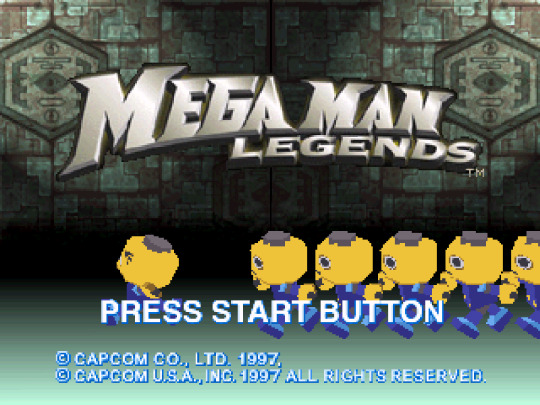
It was the year 1998 and my parents took me to Blockbuster after I begged them to allow me rent a video game. The game that I picked out would be my first experience with the Mega Man games and arguably the most atypical title in that series. Hey it's Larsa here and this time I'll be discussing the very first 3D Mega Man game: "Mega Man Legends" also known as "Rockman DASH" in Japan.
Before some of the other major titans of gaming in the 1990s went in completely new directions another iconic series led by a mascot already reinvented itself years before the larger competition. Though in the shadow of these colossal series while still being iconic itself, many the world over knew about the series of video games "Mega Man" aka "Rock Man" (ロックマン ) in Japan. Mega Man series starred Mega Man, a chibi robot who now should need no introduction. After several years of success eventually Capcom's beloved Mega Man franchise went in a bold new direction with "Mega Man X" in 1993. This new Mega Man X featured more gorgeous detailed sprite work supported by the more advanced technology on the SNES console, it told a more cohesive story, and featured more fast paced action-oriented gameplay than the original main series. Capcom's 'Blue Bomber' was successfully reinvented for the Super Nintendo but Capcom did not abandon their original blue boy and in fact Capcom continued developing titles for both series of Mega Man games side by side throughout the next several years. While Capcom had two separate main titles of Mega Man games they treated as big deals, they were looking to release Mega Man 8 and Mega Man X4 on the new consoles that came out after the SNES. These two titles would be developed for both the Sega Saturn and PlayStation putting their flag down with two strong titles on the newer consoles of the mid-1990s.
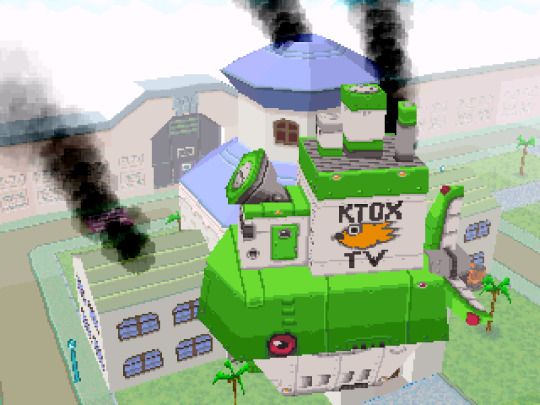
However while this console transition was happening it did not stop Capcom from reinventing the wheel yet again when they re-imagined Mega Man for three dimensional gaming. "Mega Man Legends " was a big departure from either previous two established ongoing series featuring Capcom's then-favored mascot. Instead of sprite based artwork we were now officially going to see Megaman in the world of polygons which was an exciting fresh prospect for many gamers of the time. Even though it bore the same name as a notoriously difficult franchise, this new series would be forgiving and more aimed at players of all ages according to producer Keji Infaune. For this title the Mega Man series would be focusing less on an intensive gameplay challenge and more on seeing and experiencing the world. Instead of being a challenging platformer the game would be an action-adventure title.
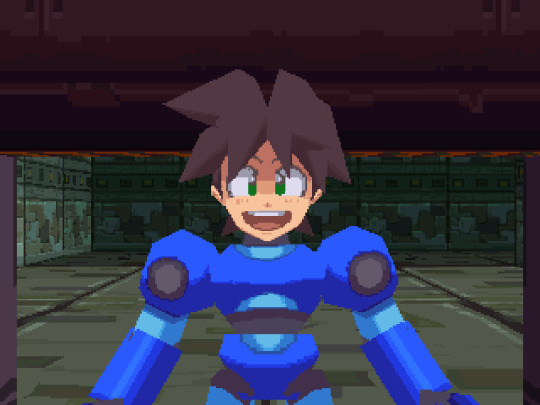
The new tone of "Mega Man Legends " is immediately communicated with one look at our new lead, "Mega Man Volnutt". Volnutt is a new cuter take on Mega Man than the then-newest interpretation featured in "Mega Man X", who is an inexperienced kid looking for the world's treasures known in this setting as a "digger". You see he is not a 'Super Fighting Robot' or a hunter of dangerous virus-infected robots bound against their own free will. Our boy Volnutt is a part of a traveling family searching for secrets of the world from ages long past. His family is made up of his dependable sister Roll Casket, a dancing monkey known as "Data", and lastly his grandpa Barrell Casket all living aboard a ship by the name "Flutter". The game starts off right away setting the stage for its brand new location "Kattelox Island" and why you the player will be staying there. At the time of your arrival a group of pirates known as "The Bonne Family" have been spotted scoping things out on the island which has made the denizens of Kattlelox anxious. Teisel Bonne, Tron Bonne, and the Servbot army serving them are real scene stealers without giving away too much. "Mega Man Legends" is an ambitious game with an emphasis on the world being a sandbox in which Volnutt can travel to a various points at essentially any time. There would be much to do on Kattlelox Island and even merely talking to the various townspeople would become interesting as they change location and gain new dialogue as the events of the story progresses. As a player it makes the world feel that much more alive when NPCs potentially talk to you about the giant robot you thwarted recently.

The entire game formula has changed in this new 3D title with an emphasis on exploration. "Mega Man Legends" has more in common with "The Legend of Zelda: Ocarina of Time" than any previous game in it's own series. Many people compare Volnutt's adventures to "Ocarina of Time" naturally but it is important to note that "Mega Man Legends" actually game out several months before Zelda's debut on the N64 console. Unlike the other "Mega Man" games which were divided into stages this new take on the series featured a town that acted as a hub and underground ruins. The winding underground ruins are vast and they all connected through various obstacles that Volnutt can knock down to create new routes connecting locations which he can do as he gains new special weapons throughout the game. Speaking of weapons, you can utilize over a dozen special armaments in addition to the traditional Mega Buster which Volnutt can equip one at a time as a "Sub-Weapon". You don't need to defeat bosses for these weapons like one would normally expect in this franchise, instead to encourage exploration you discover weapon parts from various locations on the island. Likewise Volnutt can discover parts through the mass of ancient scrapped parts that enhances his armor in various ways giving the game some light RPG elements. This game was very experimental with the things it attempted to do. A hard to notice feature of the game is a morality system that changes the color of Volnutt's armor depending on your choices on the adventure though this feature is woefully underdeveloped but it does show the dev team were shooting for the stars with this game.
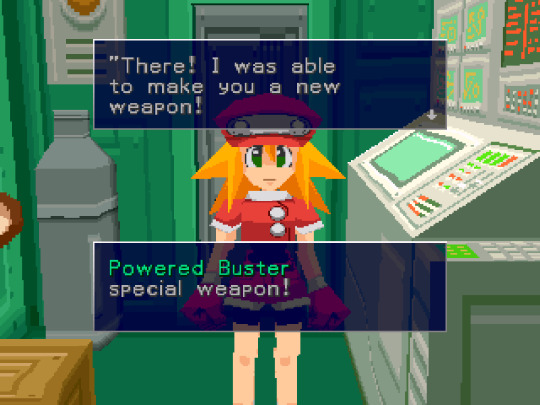
The character designs feel like they would be right at home in the late 1970s animations and overall the artstyle of "Mega Man Legends" heavily resembles old Tasunoko cartoons. I feel the inspiration is obvious for any who is familiar with series such as " Yatterman ". As a result of putting focus on such a highly stylized designs the game's look doesn't feel as aged as some of the other titles released in this time period. I believe the original musical score still sounds great to this day the music can go from whimsical to heroic depending on the scene. The songs associated with the Bonne family are my favorite tracks in the game in part because they are just plain awesome and additionally because of how much they compliment the current mood of the scenes they play during. Now with that said at times some classical scores such as " Waltz of the Flowers " for example by legendary composer Tchaikovsky make it into the game. No offense to one of the greatest musicians of all time but hearing songs like this can be a little disappointing and distracting when you enjoy the original sounds so much and feels like it undermines the setting a bit. This is the most minor of nitpicks though and it doesn't truly detract from the game. At the same time it poses an interesting question for us all to ponder over while playing this game: Such as is Tchaikovsky actually still alive in "Mega Man Legends" and producing musical bangers on Kattlelox Island?
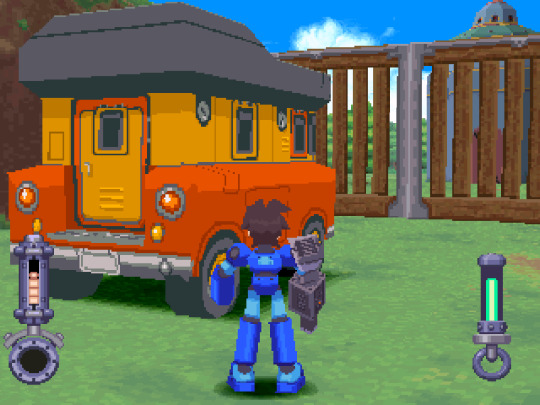
"Mega Man Legends" has some flaws and can come across as slightly primitive even for the time. Thankfully the game gives you a very endearing experience which does not overstay its welcome by becoming a game that is overly long. You could feasibly clear this game in under ten hours which is a good thing in this case because by the time you finish the game you may kind of miss it. It is the kind of game that leaves you wanting more without feeling like it didn't give you enough in the first place and the lovable cast that play role in the story stay with you as well. Capcom would eventually create a sequel title and it would also get it's own spin-off that we may discuss someday.
A gem hidden among the stones, Mega Man Legends is unquestionably stardust.
-- Larsa
#gaming#video games#retro gaming#retro games#playstation#ps1#psone#psx#capcom#megaman#mega man#mega man legends#megaman legends#acquired stardust#game spotlights#Larsa
17 notes
·
View notes